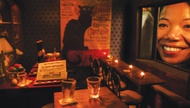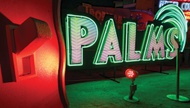Sush Machida wants to bring you closer to God, and he's using paint to do it. "Nature is God," attests Machida. "(There is) no God in Vegas. (I'm) making God." Mischievously jarring, the claim also is debatable. Face to face with the subtle beauty of a raw desert landscape, such a bold statement seems reckless at best and unconsidered at worst. But a visit to Centerpiece Gallery's current installment of its hugely rewarding Locals Only series suggests Machida might just have a point.
Although this is Machida's first commercial solo show in Las Vegas, the 2002 UNLV MFA graduate's signature aesthetic is easily identified by enthusiastic locals. His canvases masterfully negotiate the collision of Eastern and Western cultures in an almost hallucinogenic kaleidoscope of shape, color and composition. A key component of this sizzle is the artist's strategy of quoting traditional Japanese genres like ukiyo-e (floating world) and karesansui (Zen gardens) in composition and content.
The Details
- Sush Machida

- Through November 7
- daily, 10 a.m.-6 p.m.; free
- CENTERpiece Gallery at CityCenter, 739-3314
Consciously considering what it means to make a painting "contemporary," Machida embraces the precision of hard edge (Karl Benjamin, John McLaughlin) as pure 21st-century methodology: super clean and design conscious. In Machida's paintings, the cool precision of this Southern California style meets the languor of the West Coast, home to some of America's most stunning natural vistas. Throw in Machida's bestiary of goldfish, phoenixes, dragons and whales and you have fine examples of 21st-century nature painting.
Brightly illuminated by colorful pop precision, Machida's paintings are equally organic. Undulating shapes, generated by a mixture of hand application and spray-painted pigment, avoid the super flat, resulting in a silky-smooth rhythm that luxuriates in the wetness of the medium—like Al Green covering a Beach Boys song.
There is a lively balance between taut restraint and all-out fecundity. And even though almost every painting features an animal, water (and allusions to it) is everywhere. "Three Seas" is a grand, black triptych that devours the viewer in lilting waves with hints of flirtatious color. The clean, white expanse of vibrantly hued, swelling arcs oscillating between air and water in "Sorairo" made me thirsty.
The sharp "S" curl in "Dragon" explodes in exuberant color, metaphorically held together by a tube of Super Glue. Pop references are all over the place (a Chanel bottle, a pack of cigarettes), but don't assume these icons reference Eastern cultural trends. While the artist claims that any association to floating world woodcut prints and its superstar, Hokusai, is purely accidental, Machida often slyly refers to popular Western cultural conceits via ancient Japanese compositional formulas. (Sport fishing photos, for example). Two, small storyboard-like drawings offer a seldom-seen glimpse into the artist's loose, organic process.
While I can't say that I saw God, Machida has fashioned an undeniably fantastical world quite unlike anything else.






Previous Discussion: